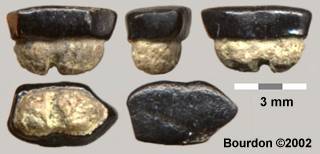| |
Unlike most stingray teeth, those of Hypolophodon are quite mundane - bilobate
roots and a high, lozenge-shaped crown. Closer inspection however, does reveal some
distinct characteristics. Viewed occlusally, the crown is weakly hexagonal and the
enameloid smooth. The lingual face bears low & broad enameloid ridges, the central one
may continue to form a weak uvula. The labial face is smooth. When viewed laterally,
a low, lingually positioned transverse ridge can be seen (or at least imagined).
The broad roots are bilobate and do not extend beyond the labial, lingual or lateral faces
of the crown. The deep nutrient groove bears multiple foramina of differing sizes.
When unworn, the lingual faces of the root have basio-apical depressions that, according
to Cappetta (1987), lead to foramina just below the crown. He also notes that the teeth
may be up to 7 mm (5.5 is the largest yet observed by the author from the Nanjemoy)
in width and come from a grinding dentition. (The 35 or so teeth I've examined from the
Nanjemoy are smoothly worn, not reflecting the wear patterns associated with the grinding
dentitions of the myliobatids.) He includes this genus in Lower Eocene faunas of Europe
& Western Africa.
Ward & Wiest (1990) list Hypolophodon sylvestris (WHITE 1931)
in the Palaeocene & Lower Eocene of Europe, West Africa and the Chesapeake Region
(Maryland & Virginia).
 |
Fig. 1 - Hypolophodon cf sylvestris
Aquia Formation level 2, Maryland |
 |
Fig. 2 - Hypolophodon cf sylvestris
hgt = 2.8, wid = 4.0, dep = 2.8 mm
Potapaco Member, Nanjemoy Formation, Virginia |
|